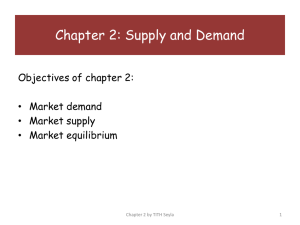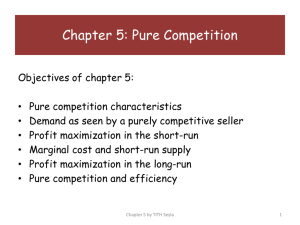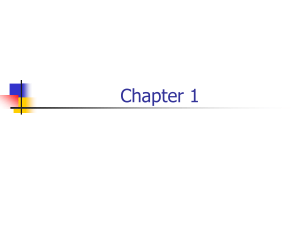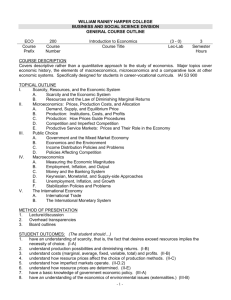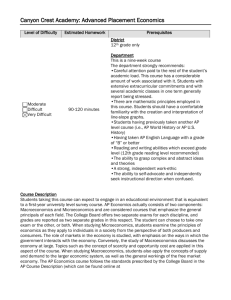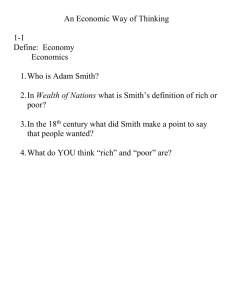Objectives of chapter 1
advertisement
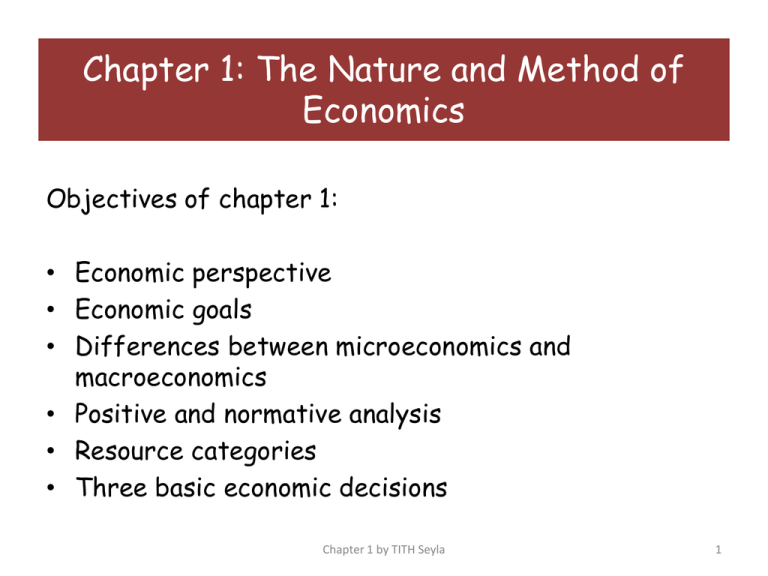
Chapter 1: The Nature and Method of Economics Objectives of chapter 1: • Economic perspective • Economic goals • Differences between microeconomics and macroeconomics • Positive and normative analysis • Resource categories • Three basic economic decisions Chapter 1 by TITH Seyla 1 I. Economic Perspective • Scarcity – Resources are limited. • Find 10 resources which are limited. – Human needs are unlimited. • • Choice Tell your 3 most important needs to the class. – People make choices because they can not choose everything they want. • Tell 2 cases in which you want to choose two things but you can choose only one thing. – When you choose one thing, you must abandon another thing. • Tell the class what you have abandoned to be here. • Opportunity cost – The cost of something is what you give up to get it. There is no free lunch! Chapter 1 by TITH Seyla 2 II. Economic Goals (a) • Economic growth – To produce more and better goods & services, which means to develop higher standard of living. – What is GDP? How is it measured? What does the number indicate? • Full employment – To provide stable jobs for all citizens who are willing and able to work. – What is unemployment rate? How is it measured? What does the number indicate? • Economic efficiency – Achieve the maximum full filament of wants using the available productive resources. Chapter 1 by TITH Seyla 3 II. Economic Goals (b) • Price level stability – To avoid large upswing and downswing in the general price level, that is avoid inflation and deflation. • Economic freedom – To guarantee that business, worker, and customers have high degree of freedom in their economic activities. • Equitable distribution of income – To ensure that no group of citizen faces poverty while most others enjoy abundance. • Economic security – To provide for those who are chronically ill, disable, laid off, aged, or otherwise unable to earn minimal levels of income. Chapter 1 by TITH Seyla 4 II. Economic Goals (c) • Balance of trade – To seek a reasonable overall balance with the rest of the world in international trade and financial transactions. Chapter 1 by TITH Seyla 5 III. Macroeconomics and Microeconomics • Macroeconomics – To examine the economy as a whole or its basic subdivisions or aggregates sectors. – To speak of such economic measures as total output, total employment, total income, aggregate expenditures and the general level of prices in analyzing various economic problems. • Microeconomics – To look at specific economic units, the economist observe the detail of an economic unit or very small segment of the economy. – To talk about individual industry, firm, household. – To measure the price of specific product, the revenue of particular firm, government entity or family. Chapter 1 by TITH Seyla 6 IV. Positive and Normative Economics • Positive economics – To focus on facts and cause-effect relationships. – Try to establish scientific statements about economic behavior and deal with what the economic is actually like. – Avoid value judgments and include description, theory development and theory testing. • Normative economics — Value judgments about what the economy should be like. — Expression of support for particular economic policies. — Source of debate among economists and policy makers. Chapter 1 by TITH Seyla 7 V. Resource Categories (a) There are 4 important resources as the following: 1. Land: include all natural resources such as arable land, forests, mineral and oil deposits and water resources. 2. Capital (capital goods or investment goods): include all manufactured aids used in producing consumer goods and services such as tools, machinery, equipment, factory storage, transportation and distribution facilities. 3. Labor: the physical and mental of individual available and usable in producing goods and service such as teacher, professional football player, accountant… Chapter 1 by TITH Seyla 8 V. Resource Categories (b) There are 4 important resources as the following: 4. Entrepreneur ability: special human resource, distinct from labor. The entrepreneur perform several function as: – To be an innovative person: take the initiative in combining the resource of land, capital and labor(factor of production). – To be a decision maker: make basic business policy decision. – To be an innovator: commercialize new products, new production technique or new form of business organization. – To be a risk bearer. ` Chapter 1 by TITH Seyla 9 VI. Three Basic Economic Decisions There are 3 main questions as the following: 1. What will be produced?: Decision must be made about what to produce and how much of each item to produce with the limited resources available. To balance needs and want of various groups. 2. How will goods and services be produced?: Productive methods that squeezed the most out of available means allow the great possible material well-being from limited resources. 3. To whom well goods and service be distributed?: to know clearly about demand. Chapter 1 by TITH Seyla 10 Chapter 1 - Summary Economic perspective: scarcity + unlimited wants = choice -> opportunity cost Economic goals: economic growth, full employment, economic efficiency, price level stability, economic freedom, equitable distribution of income, economic security, balance of trade. Macroeconomics and microeconomics Positive and normative economics Resource categories: land, capital, labor, entrepreneurial ability Three basic economic questions: What, How, To Whom/where? Chapter 1 by TITH Seyla 11
